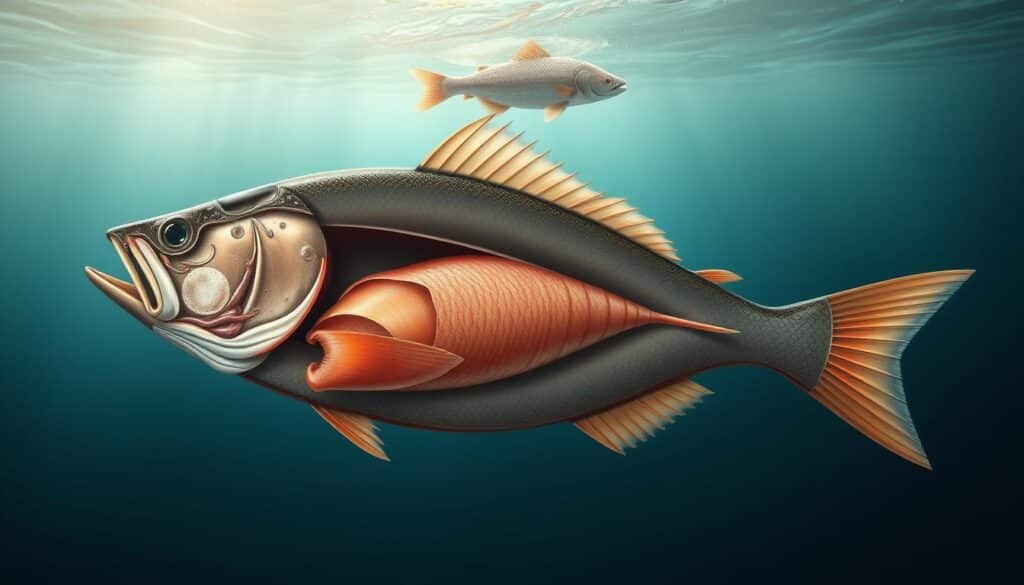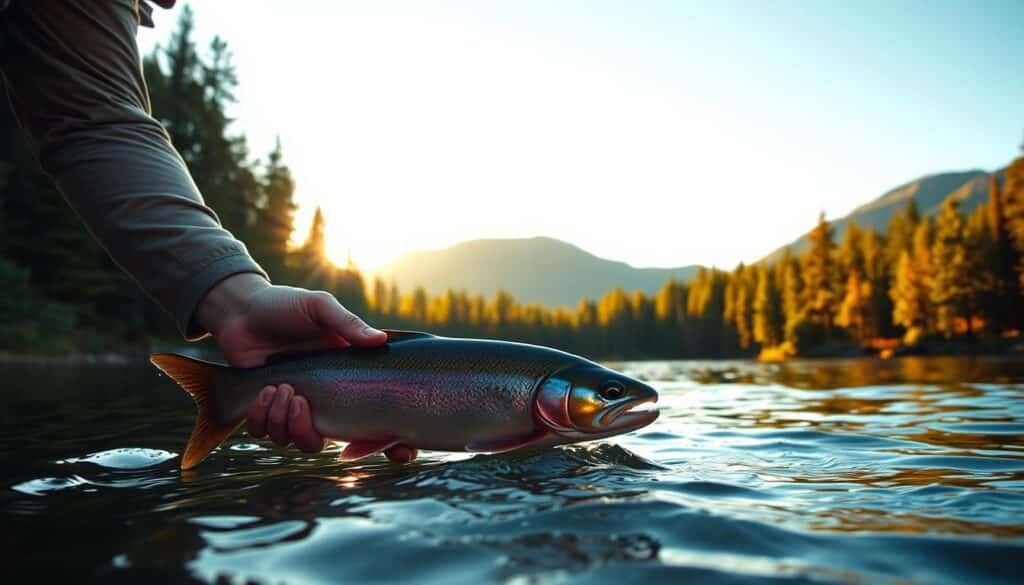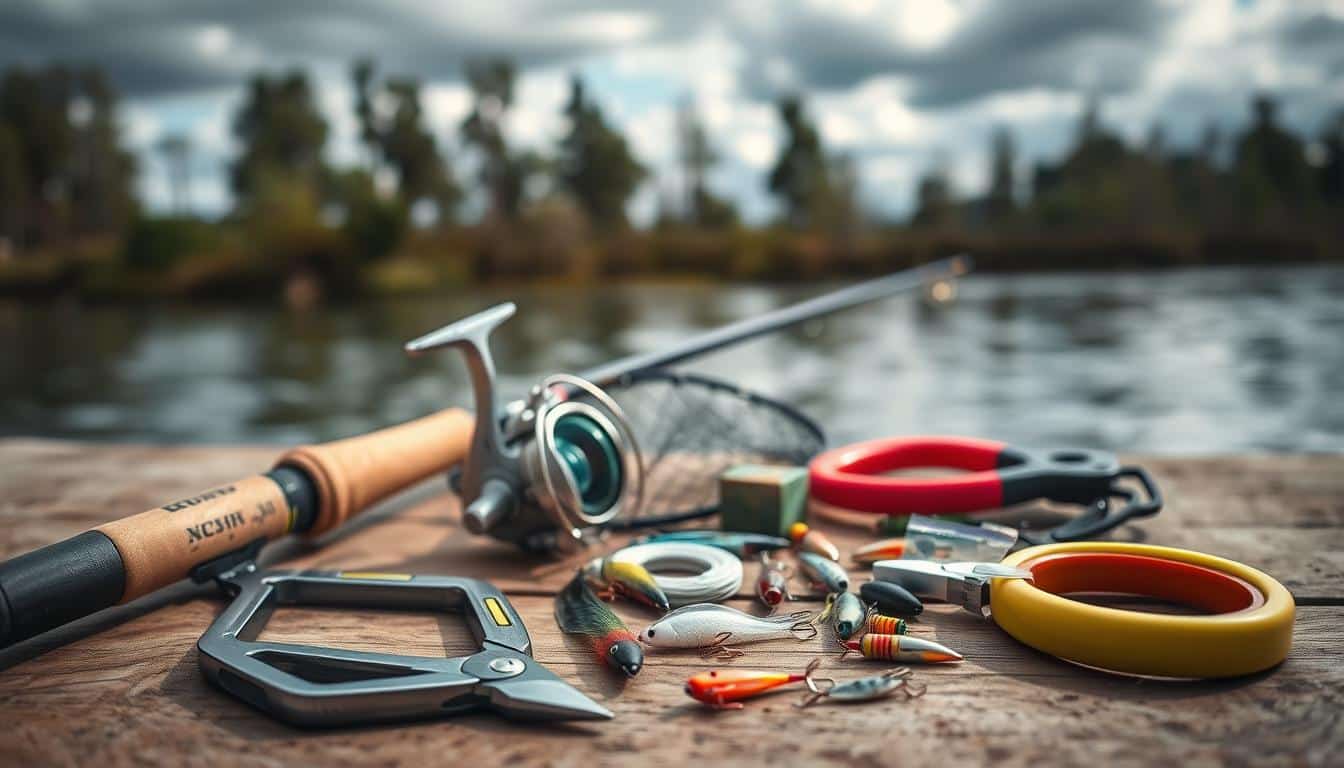Catch and release is simple: anglers let the fish go back into the water right away. This method is key for keeping fish populations healthy. It helps make sure there are enough fish for everyone in the future.
Sustainable fishing is about making smart choices. We need to use the right gear and let fish go quickly. More than a third of people eat seafood for protein. Around 38 million people have jobs catching fish. So, doing catch and release well is vital for both nature and people.
We’ll look at the best ways to make sure fish survive after being released. Things like using specific hooks and nets help. We will also discuss when it’s okay to keep some fish. Plus, how catch and release fits with managing fish stocks.
Why sustainable fishing matters for food security and coastal communities
Sustainable fishing connects oceans with our meals and supports local economies. It ensures billions get vital seafood protein, aiding coastal jobs and food affordability. Fisheries guided by science lower risks to both diets and earnings.
The role of fisheries in global food supply
Wild-capture fisheries are key for animal protein worldwide. This seafood is nutrient-rich and often more affordable than other meats, essential in poorer coastal regions. When managed well, fisheries can increase sustainable catches, making seafood more accessible.
Economic importance: livelihoods and employment in wild-capture fisheries
Around 38 million people make their living from the fishing industry. This includes fishers, sellers, and those who transport fish. These jobs are crucial for coastal economies and help keep money flowing in harbor cities and small islands.
Consequences of overfishing on local communities and long-term food availability
Overfishing reduces fish numbers and disrupts ecosystems. High catches can lead to smaller hauls, higher prices, and weaker food security. If we don’t manage fishing better, coastal communities could lose income and face more hunger risks.
- Science-backed rules can increase long-term fish yields and secure steady seafood protein.
- Protecting fish that can reproduce ensures future harvests and supports coastal jobs.
- Addressing overfishing helps avoid fish stock crashes and fights poverty in fishing villages.
How catch and release supports sustainable fish stocks
Catch and release is key to keeping fish populations healthy. It allows managers to use science to make rules. Anglers must grasp simple handling techniques. They also need to heed size and season tips. This way, recreational fishing doesn’t kill fish by accident. It gives time for fish numbers to grow again. This method, along with set catch limits and monitoring, leads to lasting fish stock health.
Protecting breeding adults to maintain reproductive capacity
Letting go of adult fish keeps breeders safe. These big fish are vital because they lay more eggs and have stronger babies. By saving these key fish, anglers aid in keeping fish diverse and numbers steady. This action helps fish populations stay strong over time.
Population recovery potential when anglers release fish properly
- Using right gear like circle hooks cuts down injury.
- Keeping fish wet and handled gently boosts their survival.
- Releasing fish the right way means they can grow and have babies, helping fish numbers bounce back.
How catch and release complements science-based harvest control rules
Catch and release adds another layer of safety for fish. It goes hand in hand with rules on when and how much fish can be caught. Anglers who let fish go help reduce deaths from fishing. Working together in this way makes recovery efforts stronger. It also helps fishery managers meet their goals for keeping fish stocks healthy.
Programs and outreach encourage anglers to follow these steps. When fishers use these best practices, it helps keep fish numbers up. It also backs up policies made for fish to thrive long-term.
Practical catch and release techniques for higher survival
Using good gear and handling fish gently are key for their survival after release. Choose fishing tackle that helps you land fish quickly to prevent exhaustion. Have your tools handy to quickly and calmly release the fish back into the water.
Picking the right hooks and line is crucial to reduce injury and speed up the release. Circle hooks are better because they prevent deep hooking and are easy to remove. For bait fishing, using circle hooks instead of J-hooks can help fish survive better.
Barbless hooks or hooks with pinched barbs allow for quicker removal and less harm. If you’re worried about swallowed hooks, non-stainless hooks are preferable as they break down over time.
The process of landing and handling starts the moment you hook a fish. Bring the fish in quickly to decrease the time it struggles. When touching fish, use wet hands or gloves to protect them. Always handle fish carefully, keeping them horizontal and not hanging by the jaw.
- Choose knotless or soft rubber nets to safeguard the fish’s scales and slime coat.
- Try to keep the fish in water as much as possible, limiting air exposure to less than a minute for better survival.
- Avoid using gaffs on fish you plan to release. Revive sluggish fish by gently holding them in the current until they swim away.
Always have dehookers, long-nose pliers, and line cutters with you. Dehookers help you release the fish while it’s in the water, reducing stress. If a hook gets deeply swallowed, cutting the line near the hook is safer than trying to remove it.
Small adjustments in your technique can make a big difference. Opt for circle and barbless hooks for an easier release. Use knotless nets and dehookers to handle fish less. By acting fast to minimize air exposure, you give fish a better chance at recovery.
Addressing physiological threats: barotrauma and depth-related mortality
When you fish in deep water, there are more dangers than just hooks and handling. The rapid change in pressure can harm fish, making them less likely to survive after being let go. It’s crucial for anglers to recognize these signs and have the right tools to help fish recover during a deep-water release.

- Bulging eyes, a stomach poking out of the mouth, or a swollen belly are signs of barotrauma.
- If a fish has lifted scales or swims slowly, especially after being caught below 30 feet, it may be in distress.
- Species like rockfish, snapper, and grouper are more likely to die after deep-water fishing if not handled quickly.
Tools and techniques that help:
- Descending tools like weighted clips or specialty recompression gadgets can quickly return fish to their proper depth, preventing organ injury.
- Using release weights and baskets can help safely lower fish to a depth where their bodies can adjust properly.
- Pick tools that match the fish species and depth you’re targeting. Practice using them before you need them out on the water.
When venting may be used:
- Only use sterile needles or specific venting tools if no descending device is handy, and if the local laws allow it.
- Make sure to follow guidelines for each type of fish to avoid harming them or getting your gear contaminated.
- Always try to get the fish back under water quickly instead of keeping it out too long. This increases its chance of survival.
Practical checklist for anglers:
- Make sure you have at least one descending device and a backup venting tool.
- Get comfortable with using release weights and recompression tools when the sea is calm before you try a deep-water release.
- Keep the fish out of the air as little as possible, act fast, and return the fish to deep water safely when you can.
By following these steps, anglers can help lower the chance of fish dying after release. This makes fish populations stronger for future fishing trips.
Minimizing environmental impacts beyond individual fish
It’s about more than just a single fish—it’s about the whole ecosystem. Managers and anglers need to work together to keep harm low. By picking the right time, place, and equipment, we can protect other species and the ocean floor, and still have productive fisheries.
- Use selective hooks and escape panels that let unintended species swim free.
- Shift effort away from known hotspots and seasonal aggregations of turtles, seabirds, or juvenile fish to reduce bycatch.
- Deploy bird-scaring lines, turtle excluder devices, and acoustic pingers where applicable to lower interactions with marine mammals and birds.
Prevent habitat damage
- Avoid heavy bottom contact in fragile areas such as coral, sponge grounds, and beds of slow-growing invertebrates to avoid habitat damage.
- Adopt lighter rigs, mid-water trawls, or hook-and-line methods when possible to protect benthic communities and boost seafloor protection.
- Map vulnerable habitats and set clear spatial or seasonal closures so fleets can fish without harming essential structure or nursery areas.
Mitigate lost gear
- Track and recover lost nets, traps, and lines quickly to reduce ghost fishing and entanglement.
- Fit pots and traps with biodegradable panels or timed-release mechanisms to allow escape if gear is lost, an effective lost gear mitigation strategy.
- Design gear to minimize snagging and entanglement, then test prototypes to confirm they meet conservation goals while remaining practical for fishers.
Fisheries need to prove they handle risks to other species and habitats to meet standards. When everyone commits to sustainable methods and plans well, fisheries can thrive. This means protecting marine life and the ocean floor stays healthy, too.
Ethical and cultural considerations of catch and release versus keeping catch
Fishing decides between wildlife respect and meeting community needs. Anglers balance catch and release ethics with traditions, necessity, and sustainability. In places from Iowa reservoirs to Louisiana bays, rules and values guide these choices.
Balancing respect for wildlife with cultural and subsistence needs
Indigenous and rural communities have fished for generations. These traditions may involve keeping fish for ceremonies or food. Yet, releasing some fish helps safeguard future fish populations.
When harvesting is ethical: following regulations, selective harvest, and using the whole fish
To harvest ethically, follow local size, bag limits, and seasonal rules. Selective harvest spares breeding adults and focuses on plentiful species. Using all parts of a fish reduces waste, honoring the catch.
How catch and release promotes stewardship and angler education
Careful catch and release fosters angler responsibility. Educating on proper handling and gear promotes fish survival. Informed anglers support conserving fish habitats and policies.
- Recognize local context: check species status, rules, and community values.
- Prioritize sustainable harvest when food security or tradition calls for it.
- Adopt catch-and-release best practices to strengthen angler stewardship.
Regulations, certification, and community-based management for sustainable fisheries
Effective fisheries rely on clear rules, trusted certification, and strong community ties. Science guides how much and when fish can be caught, keeping stocks healthy. Local people involved in decisions often stick to these rules better, safeguarding fish across different areas.
Science-driven catch limits, size limits, and seasonal closures
Fishery managers set catch and size limits based on science. They also decide when fishing is off-limits to protect breeding fish. If fish numbers drop, rules reduce how much can be caught to help populations bounce back faster.
Role of certification programs like the Marine Stewardship Council
Certifications like MSC’s signal that seafood is sustainably caught. This process checks fish numbers, environmental impact, and how things are run. Fisheries with this label usually have healthier fish and can sell to eco-conscious buyers.
Local collaboration and shared-stock management across jurisdictions
- States and countries need to agree on rules and enforcement for shared fish stocks.
- Local fishing communities play a part in monitoring and making rules.
- Cooperation across areas helps manage fish that roam widely.
Science, certification, and community input together make fisheries stronger. They help achieve conservation goals, support coastal jobs, and ensure steady fish supplies.
Sustainable Fishing: Why Catch & Release Matters
Catch and release helps our oceans by allowing fish to stay alive after being caught. It reduces the number of fish taken out immediately and protects those that can have babies. This method is important for fishermen, people who manage fish populations, and towns near the coast. It connects fun fishing activities with caring for our environment. Adding rules on how many fish can be caught and keeping their homes safe makes sure there are enough fish for later.

Framing the practice as a vital conservation strategy
Seeing catch and release as a way to save fish is crucial. It’s a smart tactic to lower death rates among important fish species. This helps keep the big fish that make more fish and supports places that rely on fishing to make money.
Evidence that properly practiced catch and release sustains angling opportunities
- Using the right tools like circle hooks makes it less likely for fish to get hurt.
- Handling fish gently, with wet hands, and letting them go quickly helps them live.
- Doing these things helps fish numbers grow again. This is good for tourism and fishing traditions.
How catch and release links to broader climate and ecosystem resilience
Catch and release helps our planet by keeping fish populations healthy. Strong fish populations are good for underwater plants, shellfish, and tiny sea creatures. These things capture carbon and reduce climate change impact. This way, fishing plans can be better prepared for climate changes and help our coasts stay healthy.
To get the best outcome, combine catch and release with science-based rules, protecting fish homes, and cutting down on accidentally caught fish. This full approach improves jobs, makes sure we have food from the sea, and keeps fishing fun. It also helps us deal with climate change over time.
Conclusion
This conclusion shows us how important catch and release is for responsible fishing. It helps keep our fish populations healthy by protecting those that can reproduce. With smart practices, like choosing the right hooks and handling fish carefully, we can make sure they go back into the ocean alive.
Science tells us how to fish without harming the future of our oceans. By using tools like knotless nets and dehookers, we help fish survive after we catch them. It’s all about fishing smartly so we have fish for years to come.
Fishing is more than just a hobby; it’s a responsibility. We need to know the rules, help others learn about sustainable fishing, and work with our communities. By doing this, we’re making sure our children and grandchildren can enjoy fishing just like we do.
FAQ
What is catch and release?
Why does catch and release matter for food security and coastal communities?
How does protecting breeding adults help fish populations?
Can catch and release actually help populations recover?
How does catch and release complement science-based harvest control rules?
What gear choices improve post-release survival?
What are best practices for landing and handling fish?
Which tools help with safe dehooking and release?
What is barotrauma and how do I recognize it?
How can anglers address barotrauma to improve survival?
When is venting appropriate and what safety precautions apply?
How can anglers avoid exhausting fights and improve survival?
What steps reduce bycatch and harm to non-target species?
How can fishing practices protect sensitive seafloor habitats?
What can be done about lost gear and ghost fishing?
How do ethical and cultural considerations affect catch-and-release practice?
When is harvesting ethical and how can it be done responsibly?
How does catch and release promote stewardship and angler education?
What role do regulations and certification play in sustainable fisheries?
Why is local and cross-jurisdiction collaboration important?
Does catch and release connect to broader ecosystem and climate goals?
What immediate actions can U.S. anglers take to maximize conservation outcomes?
How does catch and release fit into an integrated strategy for sustainable fisheries?
Content created with the help of Artificial Intelligence.



